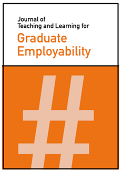Collaborative strategies for designing employability curriculum in a liberal arts context
DOI:
https://doi.org/10.21153/jtlge2024vol15no2art2046Keywords:
Employability, curriculum, collaborative curriculum development, work-integrated learning, arts, multidisciplinary, team development, peer-supported teaching practiceAbstract
In Australian higher education, the push for curriculum innovation to enhance graduate employability is crucial but faces contention and debate. While the importance of integrating employability skills is widely recognised, perspectives on how and whether to incorporate these as curricular objectives vary, especially in liberal arts programs. This paper explores a multidisciplinary academic team’s experiences of embedding employability units into the Bachelor of Arts and undergraduate Communication and Creative Arts degrees at one Australian university. It addresses the challenges of diverse disciplinary perspectives on employability, career education, and work-integrated learning (WIL), and the design for a diverse student cohort, including career starters, career advancers, and career changers from multiple disciplinary contexts. Utilising Tuckman’s ‘forming, storming, norming, and performing’ model, the paper evaluates the team’s dynamics, offering insights and guidance for academics and institutions undertaking similar curriculum innovation projects to enhance graduate employability. This case study highlights the institutional support necessary for fostering sustainable curriculum reforms and the positive effects of collaborative curriculum design on the professional development and teaching capabilities of the educators involved.
Metrics
References
The Australasian Council of Deans of Arts, Social Sciences and Humanities. (2018). Humanities, Arts and Social Sciences (HASS) Degrees: Powering Workforce Transformation Through Creativity, Critical Thinking and Human Interaction. https://dassh.edu.au/wp-content/uploads/DASSH_HASS_and_Future_Workforce_FINAL_Report_2018.11_.21_-1.pdf
Bennett, D., & Richardson, S. (2022). Industry snapshot: What do we know about the work of performing arts? Developing employ-ability. https://developingemployability.edu.au/wp-content/uploads/2022/09/Industry-Snapshot-Performing-Arts-GL28-1.pdf
Bird, J., van de Mortel, T., Holt, J., & Walo, M. (2015). Academics’ perceptions of continuous and collaborative curriculum review: An Australian case study. Journal of Hospitality and Tourism Management, 24, 18-24. https://doi.org/10.1016/j.jhtm.2015.07.001
Bonebright, D. A. (2010). 40 years of storming: a historical view of Tuckman’s model of small group development. Human Resource Development International, 13(1), 111-120. https://doi.org/10.1080/13678861003589099
Bridgstock, R., & Cunningham, S. (2016). Creative labour and graduate outcomes: implications for higher education and cultural policy. International Journal of Cultural Policy, 22(1), 10-26. https://doi.org/10.1080/10286632.2015.1101086
Campbell, M., Cooper, B., Smith, J., & Rueckert, C. (2022). The Framing of Employability Policy and the Design of Work-Integrated Learning Curriculum. In S. J. Ferns, A. D. Rowe and K. E. Zegwaard (Eds.), Advances in Research, Theory and Practice in Work-Integrated Learning (pp. 17-26). Routledge. https://doi.org/10.4324/9781003021049
Carson, J. (2021). ‘Re-thinking a bachelor of arts for the 21st-Century precariat’. Studies in Higher Education, 47(7), 1477-1487. https://doi.org/10.1080/03075079.2021.1916906
Colombini, C. B., & McBride, M. (2012). “Storming and norming”: Exploring the value of group development models in addressing conflict in communal writing assessment. Assessing Writing, 17(4), 191-207. https://doi.org/10.1016/j.asw.2012.05.002
Cunningham, S., & Bridgstock, R. (2012, November 1). Say goodbye to the fries: graduate careers in media, cultural and communication studies. Media International Australia Incorporating Culture and Policy, 145(1), 6-17. https://doi.org/10.1177/1329878X1214500103
De Dijn, M., Jacobs, C., Zenner, E., Ihalainen, L., Palander-Collin, M., Peterson, E., Arens, S., De Baar, M., Touwen, J., & Heyvaert, L. (2023). Skills as stepping stones for employability: Perception research into the skills of Humanities students. Arts and Humanities in Higher Education, 22(2), 194-210. https://doi.org/10.1177/14740222231156887
Gannaway, D. (2014). The Bachelor of arts: Slipping into the twilight or facing a new dawn? Higher Education Research & Development, 34(2), 298-310. https://doi.org/10.1080/07294360.2014.956689
Gleason, N. (2021, April 2). Liberal arts education must embrace employability. Times Higher Education. https://www.timeshighereducation.com/blog/liberal-arts-education-must-embrace-employability
Gregory, E., & Kanuka, H. (2024). Student perspectives on employability skills in liberal arts programs: A Canadian case. Journal of Teaching and Learning for Graduate Employability, 15(1), 126-145. https://doi.org/10.21153/jtlge2024vol15no1art1672
Gregory, E., & Kanuka, H. (2022). Employability Skill Development: Faculty Members’ Perspectives in Non-Professional Programs. Canadian Journal of Career Development, 21(1), 6-19. https://doi.org/10.53379/cjcd.2022.120
Handelzalts, A. (2019). Collaborative Curriculum Development in Teacher Design Teams. In J. Pieters, J. Voogt, & N.P. Roblin (Eds.), Collaborative Curriculum Design for Sustainable Innovation and Teacher Learning (pp. 159-173). Springer. https://library.oapen.org/bitstream/handle/20.500.12657/22872/1007289.pdf?sequence=1#page=166
Hansen, L., Chambers, T., & Hamilton, D. (2023). Peer-Supported Teaching Practice: Embodying a Relational, Practice-Led Approach to Enhancing Educator Wellbeing and Practice. Student Success, 14(3), 65-77. https://doi.org/10.5204/ssj.2780
Harvey, N., & Shahjahan, M. (2013). Employability of Bachelor of Arts graduates: Final Report. Office for Learning and Teaching, Sydney. https://ltr.edu.au/resources/CG9_1156_Harvey_Report_2013_1.pdf
Jonker, H., März, V., & Voogt, J. (2019). Collaboration in teacher design teams: Untangling the relationship between experiences of the collaboration process and perceptions of the redesigned curriculum. Studies in Educational Evaluation, 61(June), 138-149. https://doi.org/10.1016/j.stueduc.2019.03.010
Kilag, O. K. T., Morales Jr, N. M., Marquita, J. A., & Laurente, J. C. (2023). Teacher-Led Curriculum Development: Fostering Innovation in Education. Excellencia: International Multi-Disciplinary Journal of Education, 1(4), 223-237. https://multijournals.org/index.php/excellencia-imje/article/view/53/56
Klein, E., & Walton, J. (2023). Mapping future work skills in the bachelor of arts: findings from an Australian study. Higher Education Research & Development, 43(1), 104-118. https://doi.org/10.1080/07294360.2023.2228218
Rickards, T., & Moger, S. (2000). Creative leadership processes in project team development: An alternative to Tuckman’s stage model. British Journal of Management, 11(4), 273-283. https://doi.org/10.1111/1467-8551.00173
Sin, C., Tavares, O., & Amaral, A. (2019). Accepting employability as a purpose of higher education? Academics’ perceptions and practices. Studies in Higher Education, 44(6), 920-931. https://doi.org/10.1080/03075079.2017.1402174
Tam, A. C. F. (2015). The role of a professional learning community in teacher change: A perspective from beliefs and practices. Teachers and Teaching Theory and Practice, 21(1), 22–43. https://doi.org/10.1080/13540602.2014.928122
Tuckman, B. W. (1965). Development Sequence in Small Groups. Psychological Bulletin, 63(6), 384-399.
Tuckman, B. W., & Jensen, M. A. C. (1977). Stages of Small-Group Development Revisited. Group & Organization Studies, 2(4), 393-516. https://doi.org/10.1177/105960117700200404
Yorke, M. (2006). Employability in higher education: what it is – what it is not. The Higher Education Academy. https://s3.eu-west-2.amazonaws.com/assets.creode.advancehe-document-manager/documents/hea/private/id116_employability_in_higher_education_336_1568036711.pdf
Downloads
Published
Issue
Section
License
Copyright (c) 2024 Katrina Clifford

This work is licensed under a Creative Commons Attribution-NonCommercial 4.0 International License.












